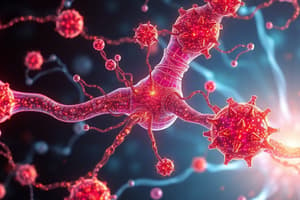Podcast
Questions and Answers
What are the prototypes of physostigmine?
What are the prototypes of physostigmine?
- Physostigmine (Antilirium)
- Pyridostigmine (Mestinon)
- Neostigmine (Prostigmin)
- All of the above (correct)
What is the therapeutic class of physostigmine?
What is the therapeutic class of physostigmine?
Antidote for anticholinergic toxicity
What is the pharmacologic class of physostigmine?
What is the pharmacologic class of physostigmine?
Acetylcholinesterase inhibitor
Match the following actions and uses of physostigmine:
Match the following actions and uses of physostigmine:
What are the adverse effects of physostigmine?
What are the adverse effects of physostigmine?
What is the antidote for physostigmine?
What is the antidote for physostigmine?
What are contraindications for using physostigmine?
What are contraindications for using physostigmine?
Administer physostigmine slowly over ______ to avoid seizures and respiratory distress.
Administer physostigmine slowly over ______ to avoid seizures and respiratory distress.
What is the onset time for administering physostigmine via IM/IV?
What is the onset time for administering physostigmine via IM/IV?
What can enhance toxic effects caused by physostigmine?
What can enhance toxic effects caused by physostigmine?
What should be monitored while using physostigmine?
What should be monitored while using physostigmine?
Flashcards are hidden until you start studying
Study Notes
Physostigmine Overview
- Physostigmine is a prototype drug also known as Antilirium.
- Related compounds include Pyridostigmine (Mestinon) and Neostigmine (Prostigmin).
Therapeutic Class
- Serves as an antidote for anticholinergic toxicity.
Pharmacologic Class
- Classified as an acetylcholinesterase inhibitor, enhancing acetylcholine levels.
Actions and Uses
- Reduces intraocular pressure (IOP) in glaucoma cases.
- Treats gastrointestinal (GI) and urinary bladder atony.
- Useful for diagnosing and managing myasthenia gravis.
- Acts to counteract anticholinergic toxicity.
Adverse Effects
- Can cause muscle weakness, a sign of Cholinergic Crisis.
- Other side effects include difficulty swallowing (dysphagia), bronchoconstriction, and dyspnea.
- May lead to bradycardia, hypotension, increased gastric acid secretion, incontinence, diarrhea, and cramps.
Antidote
- Atropine is the antidote for physostigmine overdose or toxicity.
Contraindications
- Use with caution in patients with asthma, epilepsy, diabetes, cardiovascular diseases, and bradycardia.
- Discontinue use if excessive sweating, diarrhea, or frequent urination occurs.
- Not recommended for patients with known or suspected tricyclic antidepressant (TCA) intoxication, or with GI/urinary tract obstruction, hypotension, and hyperthyroidism.
Administration Alerts
- Administer physostigmine slowly over 5 minutes to prevent seizures and respiratory distress.
- Continuous infusions should be avoided.
- Monitor blood pressure, pulse, respiratory rate, and watch for hypersalivation.
- Classified as Pregnancy Category C.
Pharmacokinetics
- Onset of action is less than 5 minutes via IM/IV administration.
- Peak effects occur within 20-40 minutes IM/IV.
- Duration of action lasts 1-2 hours IM/IV.
Drug Interactions
- Increased effects observed with cholinergic medications and beta blockers.
- Corticosteroids may elevate physostigmine levels.
- Physostigmine can reduce the effectiveness of neuromuscular blocking agents.
- Lab tests may show increased serum ALT, AST, and amylase levels.
- Ginkgo biloba can enhance toxic effects when combined with physostigmine.
Nursing Care
- Closely monitor for respiratory issues.
- When administering eye drops, apply pressure to the inner canthus to prevent drainage.
- Oral doses should be given on an empty stomach for direct action.
- Regularly monitor urinary output and bowel function to assess for cramps.
- Assist patients transitioning from lying to sitting positions.
Studying That Suits You
Use AI to generate personalized quizzes and flashcards to suit your learning preferences.





